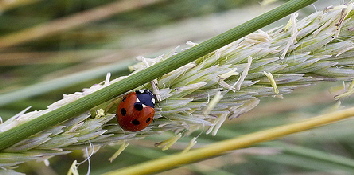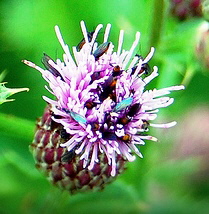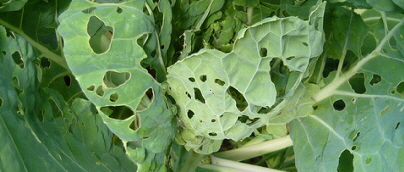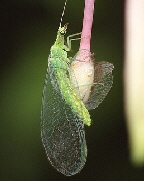Attracting Beneficial Insects
There are many insects that you will enjoy having in your garden. If you attract the beneficial insects, they will help control the pests.
The first thing you need to do to attract and keep beneficial insects is protect them. Than means no pesticides! Even occasional use of a pesticide to control a difficult pest will harm the helpful insects more than the pests. You may have that feeling that those pests are really tough and even the pesticides will have to be applied heavily to control them - and you are right! Some pests, such a fruit flies, have even learned to metabolize pesticides. The helpful guys are much more susceptible to the pesticides. So to get rid of that one tough pest, all your beneficial insects will be killed or driven out, taking your best protection with them. Nothing will deter the pests from settling in like a nice colony of predators.
A few years ago it was fashionable to purchase beneficial insects. There are a few problems with that approach. The insects available for purchase are extremely limited compared to the beneficial insects that are available naturally. You can invest a fair amount of money stocking your garden with insects, but if they don’t find the habitat they prefer in your garden, and the insects they prey on are not present, those insects you purchased are going to head for another garden anyway. Your neighbors may benefit from your purchase more than you will. And, unless you know exactly which pests are causing your problem and which predators will take care of that problem, you are wasting your money. Provide the environment in your gardens that beneficial insects are looking for, and then let nature do the rest. If there are pests, eventually the good guys are going to come along to take care of them.
So what attracts the beneficial insects? Luckily, many of the same things that you want in your garden to make it pretty, to make it healthy, and some of the extras that you provide to attract butterflies, hummingbirds and birds. How convenient!
Specifically, these are things that will attract and keep beneficial insects in your gardens:
Many beneficial insects feed on pollen and nectar so they will be attracted to many of the flowers that you plant to attract butterflies and hummingbirds. Since they are inspecting all your plants in search of nectar, they are also pollinating your vegetables and fruit. Make sure there is always something blooming for a constant food source. A variety of flowers will accommodate different feeding apparatus (mouthparts).
Establish native plants
Create garden beds with perennials that require little or no disturbing so the beneficial insects that prefer to hide underground or in the mulch are not driven out.
Make sure there are mulched, graveled or sodded areas that are never disturbed to provide areas for the predators to build a population.
Plant herbs which attract pests natural enemies.
Let a few stands of weed remain throughout your gardens or plant ornamental grasses to establish permanent residence for the beneficial insects. An area left to go wild with weed is not nearly as effective as a managed area as outlined here.
A windbreak such as hedges or fences will reduce dust blowing in on small insects and also provides extra protected cover in heat and bad weather, as well as a place for the beneficial insects to overwinter. The shrubbery will also provide additional, non threatening, insects for the beneficial insects to feed on.
Establish a butterfly and insect bath. Set up a shallow bath in flat dishes with gravel and rock platforms for the insects to light on. Make sure you keep water in it consistently and keep it fresh to avoid breeding mosquitoes.
Annuals that attract and harbor beneficial insects:
Sweet alyssum
Baby’s Breath
basil
Borage
broccolli
California poppy
candytuft
cherval
cornflower, bachelor’s button
dill
calendula
coriander
cosmos
fennel
lobelia
marigold
marjoram
parsley
radish
mustard
Native plants and perennials that attract and harbor beneficial insects:
Bishops Weed
Blanket flower
Blue lobelia
Burning bush
Catmint
Coneflower
Coreopsis
Cow parsnip
Cup plant
Elderberry
Forsythia
Firethorn
Golden Marguerite
Hyssop
Lavender
Lupine
Meadow foam
Meadowsweet
Mint family, lemonbalm, thyme
New England aster
Pale leaved sunflower
Penstemon
Peony
Pussy willow
Riddell’s goldenrod.
Scabiosa
Shrubby cinquefoil
Smooth Aster
Spotted beebalm
Stonecrop
Texas sage
Swamp milkweed
Yarrow
Yellow coneflower
Yellow giant hyssop
With so many wonderful plants to choose from, it is easy to include some or many of these to help you control pests in your garden.
If you have a problem with a specific pest, there is usually a specific beneficial insect that can help control the pest.
Certain garden pests that can damage if not decimate plants in your garden, are fairly common to many regions. Some pests even have many different predators, which gardeners consider to be beneficial insects. To avoid pesticides, you need to find out which insects will help control the pests and how to attract and keep the good guys in your gardens.
It is helpful to note that if you have insect pests damaging your plants, that is one thing that will attract the predator insects. They will, after all, go where their favorite food is. But you can also give those good guys a nice place to live and something like nectar to eat so they are right in the neighborhood when the pests come along. The previous page gives a good overview of what to provide in your gardens, but here we will cover specific information for the more common pest problems.
Common Pests and their Predators
Aphids: larvae of flower flies, larvae of predatory midges, ladybugs and their larvae, larvae of hover flies, larvae of green lacewings, braconid wasps, parasitic wasps, assassin bugs and their larvae, true bugs, minute pirate bugs, damsel bugs, soldier beetles
Borers: beneficial nematodes
Cabbageworms: parasitic wasps and mini-wasps, tachinid flies
Caterpillars: braconid wasps, larvae of hover flies, larvae of lacewings, ladybugs, assassin bugs and their larvae, larvae of parasitic flies, parasitic mini wasps, beneficial nematodes, soldier beetles
Colorado potato beetle: ladybugs, ground beetles especially soldier beetles,
Corn earworms: ground beetles, parasitic wasps and mini-wasps, tachinid flies, lacewings, minute pirate bugs, damsel bugs
Cutworms: ground beetles, spiders, tachinid flies. Birds also prey on cutworms and many of the things you do to attract insects will also attract birds.
Earwigs: larvae of parasitic flies, assassin bugs, spiders, yellow jacket (a common predatory wasp)
Fireants: spiders, flies, mites
Grasshoppers: larvae of soldier beetles, larvae of parasitic flies, praying mantis
Grubs: beneficial nematodes, spiders, ants, birds
Leafhoppers: damsel bugs, big eyed bugs
Leaf miners: braconid wasps
Mealybugs: larvae of hover flies (syrphid flies), larvae of lacewings, mealybug destroyer
Mites: true bugs, lacewing larvae
Scale insects: assassin bugs and their larvae, minute pirate bugs, ladybugs
Slugs: ground beetles, nematodes, marsh flies
Spider mites: assassin bugs and their larvae, minute pirate bugs, big eyed bugs, soldier beetles, lady bugs, lacewings
Squash bugs: spiders, tachinid flies, ground beetles
Squash vine borers: ground beetles
Tent caterpillars: parasitic wasps, assassin bugs
Thrips: true bugs, minute pirate bugs, lady bugs
Tomato fruitworm: parasitic wasps, big-eyed bus, minute pirate bugs, lacewing, damsel bugs.
Webworms: beneficial nematodes, wasps, stink bugs
Weevils: beneficial nematodes, parasitic wasps
Whiteflies: larvae of lacewings, true bugs, minute pirate bugs, ladybugs, parasitic wasp
Beneficial Insects and Their Preferences
True bugs i.e., assassin bugs including big-eyed bug, minute pirate, and damsel are one of the most important beneficial insects. Many of the true bugs feed on nectar and seeds. They can also be attracted by planting hedges or windbreaks to provide permanent habitat. Other plants that attract these insects are caraway, cosmos, fennel, peter pan goldenrod, sunflowers and marigold.
Braconid Wasps, parasitic wasps and mini wasps are one of the most important beneficial insects. The Braconid wasp is the largest, directly laying eggs in or on large caterpillars as well as aphids. The adults consume nectar and pollen while the eggs are laid in or on a host insect. They can be attracted by planting hedges or windbreaks to provide cover for the tiny wasps and permanent habitat. Other plants that attract them are yarrow, globe lily, dill, purple poppy mallow, caraway, cosmos, fennel, statice, sweet alyssum, lemon balm, parsley, sulfur cinquefoil, alpine cinquefoil, marigold, orange stonecrop, tansy and zinnia.
Ground beetles are one of the most important beneficial insects. Ground beetles like to hide in undisturbed soil, mulch, weeds or leaf litter. They feed on insect eggs and larvae as well as weedseeds Ground cover and creeping plants will help attract ground beetles.
Hover-flies (syrphid flies) and their larvae prey on aphids as well as several other insects. Hover flies can be attracted by planting asters, carpet bugleweed, dill, basket of gold alyssum, caraway, purple poppy mallow, feverfew, cosmos, sweet alyssum, Rocky Mountain penstemon, parsley, alpine cinquefoil, gloriosa daisy, stonecrops, speedwell, zinnia, goldenrod, yarrow and black-eyed susans. The adults feed on the flowers nectar and pollen.
Ladybugs are one of the most important beneficial insects. They prey on aphids, mites, whiteflies and scale. Ladybugs can be attracted by planting flowers of the daisy family, dill, butterfly weed, coriander, Queen Anne’s lace, fennel, Prairie sunflower, Rocky Mountain penstemon, Sulfur cinquefoil, alpine cinquefoil, Marigold, speedwell, tansy or yarrow. There are specialist species that specifically feed on scale, mealybugs, and mites.
Lacewings and their larvae prey on aphids as well as several other insects and are an extremely effective predator. The lacewing larvae are aptly called Aphid lions and they consume huge quantities of aphids, caterpillars, mites, etc. Lacewings can be attracted by planting asters, coriander, cosmos, dill, goldenrod, yarrow and black-eyed susan. The adults feed on honeydew, nectar and pollen while the larvae prey on insects.
Nematodes prey on cutworms, beetles and root weevil larvae. To first establish nematodes, you will likely have to purchase some. They can be encourage to multiply by providing good cover with mulch and compost. They will also enjoy plant diversity.
Praying Mantis prey on just about any pest they encounter. You may be able to attract praying mantis with cosmos, raspberries and flowering shrubs. They will enjoy lots of compost and mulch in the gardens.
Soldier Beetles prey on soft bodied insects and the eggs of the Colorado potato beetle. They like to spend the day under rocks and hiding in mulch. The adults feed on nectar and pollen as well as insect pests. Plants that will attract soldier beetles are goldenrod, hydrangea and milkweed.
Spiders are predatory and are one of the most important beneficial insects. There are thousands of species that prey on a variety of insect pests. A variety of spiders will be present as long as you do not use pesticides.
Tachinid flies are one of the most important beneficial insects. There are over a thousand species of parasitic files, many resemble the housefly. Eggs are deposited in or on a host which is then consumed by the larvae. Adults feed on nectar, pollen and honeydew. Plants that attract tachnid flies are golden marguerite, lemon balm, parsley, tansy and crimson thyme.
If you look over the lists of plants that attract the beneficial insects you will see a lot of the same plants attract many different predators. So start with those to attract the generalist predators to make it easy. Once you start to see success, and as your garden expands, you can consider adding more specific plants to attract the specialists.
Determining the best environment to attract and keep the insects you need for your garden will require some observation. Add plants a little at a time and watch carefully to see what types of insects you are attracting. Also observe the populations of pests over time. After some experimentation you will develop a lovely environment for beneficial insects. Just keep an eye on things annually, the balance and mix of insects does tend to change.









